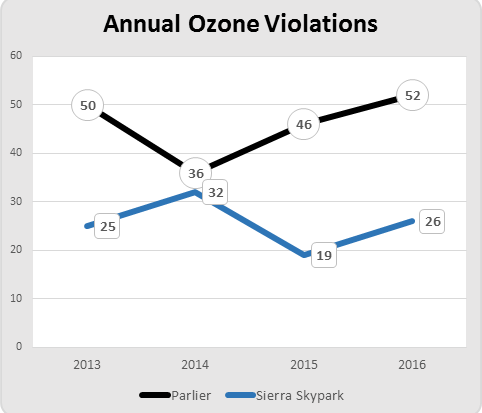
By Tom Frantz
According to the San Joaquin Valley Air Pollution Control District web page, the Valley has reduced the average number of days a resident experiences ozone levels above the national standard by 73% since 2002. Unfortunately for some, these reductions are not equally distributed. It turns out that low-income residents are often breathing worse air than their wealthier counterparts and they are also below average in their share of reductions.
A direct comparison illustrating this conclusion can be made between Sierra Skypark, an area in northwest Fresno with mostly upper-income residents, and the rural town of Parlier, including the surrounding area about 20 miles to the southeast, which has a majority of lower income residents. (Editor’s note: the town of Parlier is 97% Hispanic, while residents of Sierra Skypark are predominantly white)
The graph above shows ozone violations for the past four years at two San Joaquin Valley ozone monitors. One monitor is north of Herndon at the Sierra Skypark Airport and the other is just outside the town of Parlier at the Kearney Agricultural Research Station. Ozone is mainly a warm weather problem so we already have totals for 2016.
Just for review, according to the Environmental Protection Agency, when inhaled, ozone can damage the lungs. Relatively low amounts of ozone can cause chest pain, coughing, shortness of breath and throat irritation. It may also worsen chronic respiratory diseases such as asthma as well as compromise the ability of the body to fight respiratory infections.
Clearly, Parlier has more frequent ozone episodes than the northwest Fresno community. The Parlier monitor is considered an indicator for many nearby rural communities without monitors such as Malaga, Selma, Kingsburg, Reedley, Dinuba, and Sanger. The Sierra Skypark monitor represents the northern Fresno area adjacent to the San Joaquin River and between Hwy 99 and Clovis.
For the years 2013-2016, Parlier averaged 46 violations per year and saw slightly worsening levels overall. Sierra Skypark averaged only 26 violations per year and showed slight improvement during that time. A brief summary might say the air quality around Parlier has been approximately 80% worse than the air quality in northwest Fresno over this time period.
Obviously, the goal for both areas is to get to zero violations over the next 15 years or so. Neither place has healthy air to breathe currently. But, one obvious conclusion is that Parlier area residents directly suffer more severe health effects from ozone pollution because of their higher exposure rates. Other disparities related to wealth such as housing quality compound these issues.
Fortunately, both areas have seen improvements over the past 15 years but it looks like the Skypark area is improving faster than the Parlier area. Looking at violation numbers from 1999-2002 compared to 2013-2016, Skypark has seen a 76% drop in their total. Parlier violations have dropped only 59% over the same time period. The air district claim of an average 73% improvement in average exposure over this period may be correct but this improvement is certainly not equally distributed.
With prevailing winds coming from the northwest, the Skypark area is exposed to less pollution than the Parlier area. This is because the bulk of Fresno is in-between and there are many major industrial pollution sources the further south you go in Fresno. Winds carrying pollution down the valley do not carry much into the Skypark area. To the north near Sacramento, the City of Stockton averages only one ozone violation per year.
Wealthy people, by choice, do not live near polluting industries. Many others, especially the poor, have no choice where they live. Stronger regulations by the air district against these major polluters would actually help the poor more than the rich. Given the makeup of the air board, no one should wonder why those stronger regulations are not happening.
This disparity in ozone levels and improvement rates represents a clear environmental justice issue and is also a civil rights violation against thousands of local residents. We often hear that the rich are getting richer and the poor poorer. In terms of air quality, the rich not only have cleaner air, their air is also improving at a faster rate.
*****
Longtime clean air advocate Tom Frantz is a retired math teacher and Kern County almond farmer. A founding member of the Central Valley Air Quality Coalition, he serves on the CVAQ steering committee and as president of the Association of Irritated Residents. CVAQ is a partnership of more than 70 community, medical, public health, environmental, and environmental justice organizations representing thousands of residents in the San Joaquin Valley unified in their commitment to improving the health of Californians. For more information, visit www. calcleanair.org.
